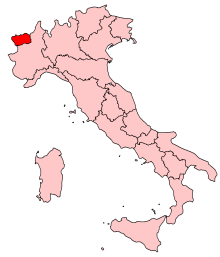Valle d'Aosta DOC

The Valle d'Aosta DOC (or Vallée d'Aoste DOC, in French
Climate and geography

The area of the Aosta valley has continental climate and despite its location in the Alps region the weather is typically very hot and dry in the summer time which tends to put harvesttime in early September. The geography of the wine regions is marked by high, steep slopes leading to the river valley which makes the use of mechanical vineyard equipment nearly impossible. The vineyard soils are composed primarily of sand at the higher elevation with more alluvial sediments of clay and gravel further down into the valley.[2]
Vineyards
The wine-making region of the Valle d'Aosta is generally divided into three areas. In the northwest, the Valdigne area south of the commune of
The Central Valley is the region's most productive area and is further sub-divided into four areas-Enfer d'Arvier, Torrette, Nus and Chambave. The Enfer d'Arvier is a red wine-producing area around the village of
The Lower Valley is known primarily for two styles of wine. The Arnad-Montjovet area produces a medium-bodied dry red wine made from at least 70% Nebbiolo with some Dolcetto, Freisa, Neyret, Pinot noir, and/or Vien de Nus. The area near the commune of Donnaz (or Donnas) produces wine made from at least 85% Nebbiolo with some Freisa, Neyret, Pinot noir and Vien de Nus.[2] Like Enfer d'Arvier, Donnas at one point had its own DOC designation.[4]
Here Nebbiolo is paler and less potent due to the high altitude[citation needed].
Other wines
Other DOC wines in the Valle d'Aosta can be
DOC regulations
For the majority of wines, DOC regulations require harvest yields below 12
References
- ^ Due to the official bilingual status of the Aosta Valley.
- ^ ISBN 0-7645-5355-0
- ^ d'Agata, Ian (19 June 2018). "Mountain Magic: The Wines of Valle d'Aosta". Vinous. Retrieved 29 October 2019.
- ^ ISBN 0-7566-1324-8
- ISBN 978-1-846-14446-2
- ISBN 1-55297-720-X
